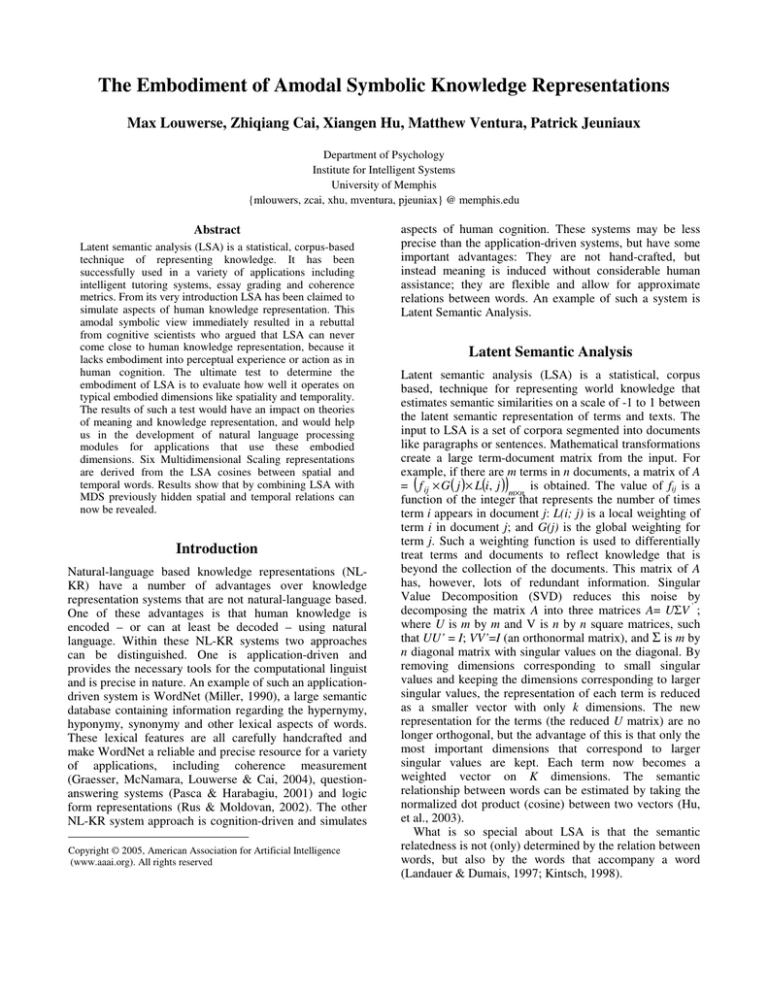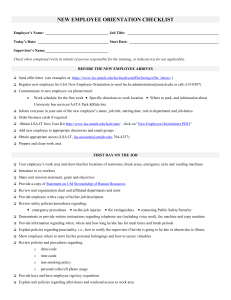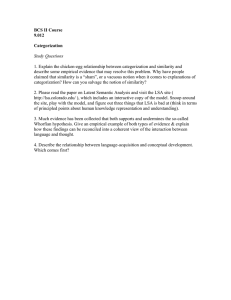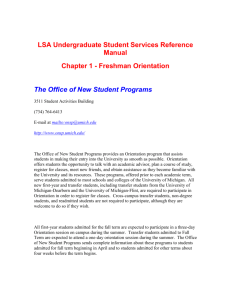
The Embodiment of Amodal Symbolic Knowledge Representations
Max Louwerse, Zhiqiang Cai, Xiangen Hu, Matthew Ventura, Patrick Jeuniaux
Department of Psychology
Institute for Intelligent Systems
University of Memphis
{mlouwers, zcai, xhu, mventura, pjeuniax} @ memphis.edu
Abstract
Latent semantic analysis (LSA) is a statistical, corpus-based
technique of representing knowledge. It has been
successfully used in a variety of applications including
intelligent tutoring systems, essay grading and coherence
metrics. From its very introduction LSA has been claimed to
simulate aspects of human knowledge representation. This
amodal symbolic view immediately resulted in a rebuttal
from cognitive scientists who argued that LSA can never
come close to human knowledge representation, because it
lacks embodiment into perceptual experience or action as in
human cognition. The ultimate test to determine the
embodiment of LSA is to evaluate how well it operates on
typical embodied dimensions like spatiality and temporality.
The results of such a test would have an impact on theories
of meaning and knowledge representation, and would help
us in the development of natural language processing
modules for applications that use these embodied
dimensions. Six Multidimensional Scaling representations
are derived from the LSA cosines between spatial and
temporal words. Results show that by combining LSA with
MDS previously hidden spatial and temporal relations can
now be revealed.
Introduction
1
Natural-language based knowledge representations (NLKR) have a number of advantages over knowledge
representation systems that are not natural-language based.
One of these advantages is that human knowledge is
encoded – or can at least be decoded – using natural
language. Within these NL-KR systems two approaches
can be distinguished. One is application-driven and
provides the necessary tools for the computational linguist
and is precise in nature. An example of such an applicationdriven system is WordNet (Miller, 1990), a large semantic
database containing information regarding the hypernymy,
hyponymy, synonymy and other lexical aspects of words.
These lexical features are all carefully handcrafted and
make WordNet a reliable and precise resource for a variety
of applications, including coherence measurement
(Graesser, McNamara, Louwerse & Cai, 2004), questionanswering systems (Pasca & Harabagiu, 2001) and logic
form representations (Rus & Moldovan, 2002). The other
NL-KR system approach is cognition-driven and simulates
1
Copyright © 2005, American Association for Artificial Intelligence
(www.aaai.org). All rights reserved
aspects of human cognition. These systems may be less
precise than the application-driven systems, but have some
important advantages: They are not hand-crafted, but
instead meaning is induced without considerable human
assistance; they are flexible and allow for approximate
relations between words. An example of such a system is
Latent Semantic Analysis.
Latent Semantic Analysis
Latent semantic analysis (LSA) is a statistical, corpus
based, technique for representing world knowledge that
estimates semantic similarities on a scale of -1 to 1 between
the latent semantic representation of terms and texts. The
input to LSA is a set of corpora segmented into documents
like paragraphs or sentences. Mathematical transformations
create a large term-document matrix from the input. For
example, if there are m terms in n documents, a matrix of A
= f ij × G ( j )× L(i, j ) m×n is obtained. The value of fij is a
function of the integer that represents the number of times
term i appears in document j: L(i; j) is a local weighting of
term i in document j; and G(j) is the global weighting for
term j. Such a weighting function is used to differentially
treat terms and documents to reflect knowledge that is
beyond the collection of the documents. This matrix of A
has, however, lots of redundant information. Singular
Value Decomposition (SVD) reduces this noise by
decomposing the matrix A into three matrices A= UΣV ' ;
where U is m by m and V is n by n square matrices, such
that UU’ = I; VV’=I (an orthonormal matrix), and Σ is m by
n diagonal matrix with singular values on the diagonal. By
removing dimensions corresponding to small singular
values and keeping the dimensions corresponding to larger
singular values, the representation of each term is reduced
as a smaller vector with only k dimensions. The new
representation for the terms (the reduced U matrix) are no
longer orthogonal, but the advantage of this is that only the
most important dimensions that correspond to larger
singular values are kept. Each term now becomes a
weighted vector on K dimensions. The semantic
relationship between words can be estimated by taking the
normalized dot product (cosine) between two vectors (Hu,
et al., 2003).
What is so special about LSA is that the semantic
relatedness is not (only) determined by the relation between
words, but also by the words that accompany a word
(Landauer & Dumais, 1997; Kintsch, 1998).
(
)
LSA in Knowledge Representation Applications
The method of statistically representing knowledge has
proven to be useful in a variety of studies. It has been used
as an automated essay grader, comparing student essays
with ideal essays (Landauer, Foltz & Laham, 1998) and
performs as well as students on TOEFL (Test of English as
a foreign language) tests (Landauer & Dumais, 1997).
More recently, LSA has also been used for several other
applications. First, it plays an important role in Coh-Metrix
(Graesser, McNamara, Louwerse & Cai, 2004; Louwerse,
McCarthy, McNamara & Graesser, 2004), a web-based
tool that analyzes texts on over 50 types of cohesion
relations and over 200 measures of language, text, and
readability. LSA measures the semantic relatedness
between sentences, paragraphs and texts.
LSA has also been used in intelligent tutoring systems
like AutoTutor. AutoTutor engages the student in a
conversation on a particular topic like conceptual physics
or computer literacy. The system assists students in actively
constructing knowledge by holding a conversation in
natural language. AutoTutor uses LSA for its model of the
world knowledge and determines the semantic association
between a student answer, and ideal good and bad answers
(Graesser, Wiemer-Hastings et al., 2000). The
computational architecture of AutoTutor and its learning
gains have been discussed extensively in previous
publications (Graesser, VanLehn, et al., 2001).
Recently, intelligent systems have been developed that
communicate with a human conversational partner on
finding a route on a map, called Intelligent MapTask
(iMAP) agents (Louwerse, et al., 2004). This constrained
semantic domain triggers a highly interactive, incremental
conversation and allows us to carefully measure the
interaction of modalities like eye gaze, intonation, dialog
structure and gestures. LSA would be an immediate choice
for the knowledge representation of the iMAP system but it
is unclear how LSA performs on dimensions like time and
space. In fact, it may be questionable whether LSA can
map space and time in the first place. This issue has also
been relevant for the question whether LSA simulates
human cognition.
LSA as Knowledge Representation Theory
Since its early days LSA has been considered to provide a
solution to Plato’s problem, the problem of how observing
a relatively small set of events can result in knowledge
representations that are adaptive in a large, potentially
infinite variety of situations (Landauer & Dumais, 1997). It
does this by mapping initially meaningless words into a
continuous high dimensional semantic space, more or less
simulating cognition (Landauer, 1999). More specifically, a
first-order process that associates stimuli (words) and the
contexts they occur in (documents). This process is very
much like classical conditioning where stimuli are paired
based on their contiguity or co-occurrence. These local
associations are next transformed by means of SVD into
more unified knowledge representations by removing
noise. Like language comprehension, memory for the initial
local associations (surface structure) becomes memory for
more global representations (central meaning). LSA can
thereby be seen as a theory of knowledge representation,
induction and language acquisition (Landauer & Dumais,
1997; Landauer, 2000; Louwerse & Ventura, 2004).
But many psychologists and cognitive scientists have
argued that corpus based models of word meaning can
simply not be the whole story. For instance, embodied
theorists (Barsalou, 1999; Glenberg and Robertson, 2000)
claim that the basis of linguistic and non-linguistic
understanding is the sensorimotor experiences of actions.
Consequently, associative models using only amodal
symbols can never fully identify the meanings of words. It
is like learning a language in a foreign country with only a
dictionary: Without grounding the words to bodily actions
in the environment we can never get past defining a symbol
with another symbol.
The response to this embodied view of meaning is
simple: LSA simply does not have the advantage of raw
perception and motoric intentions and one could predict
that if these perceptual symbols were to be included in LSA
its performance may be even more impressive than its
current record. So a solution to the embodiment problem in
LSA is to supply LSA with perceptual elements (Landauer,
1999; 2000). The problem is that “these [perceptually
grounded] frames are organized by space and time, not
simply by associative strength” and therefore “a simple
extension of LSA from words to perception probably will
not work” (Barsalou, 1999: 639).
In sum, space and time are the key challenges for LSA,
because these are typically embodied and can thus
presumably not be modeled in an amodal symbolic
knowledge representation. This problem from a cognitionbased perspective also has implications for the applicationbased approach: If LSA cannot deal with space and time it
may not be the right NL-KR system for intelligent systems
that deal with spatial tasks, like iMAP agents (Louwerse, et
al., 2004). In a number of observations we take up this
challenge and investigate to what extent LSA can actually
simulate spatial and temporal dimensions in an embodied
kind of fashion.
Method
As we outlined earlier LSA’s knowledge of the world
comes from a set of corpora segmented into documents like
paragraphs or sentences. All evidence suggests that larger
corpora benefit the performance of LSA. For all six studies
that follow we therefore selected the (commonly used)
Touchstone Applied Science Associates (TASA) corpus
that consists of approximately 10 million words of
unmarked high-school level English text on Language arts,
Health, Home economics, Industrial arts, Science, Social
studies, and Business. This corpus is divided into 37,600
documents, averaging 166 words per document.
In all observations we compared the LSA cosine output
between a set of selected words by creating a matrix of
Observation 1
In this first observation we investigated the semantic
relationships between wind directions North, South, West
and East by applying MDS to the LSA similarity matrix of
terms. The traditional association between terms will not
provide much more information than that these four words
have a semantic relation. For instance, North and South
have a strong semantic relation (cos = .74) and so have
West and East (cos = .76). North and West on the other
hand have a weaker semantic relation (cos = .11). In sum,
we can conclude that there are semantic similarities
between these terms. But we would like to take this one
step further: If we plot the semantic similarities in a twodimensional graph, can we obtain spatial information that
the North and South axis is orthogonal to the West and East
axis? Clearly, there is nothing in the co-occurrences and
semantic associations that would suggest this orthogonal
relation. After computing the cosine values between these
terms, the symmetric matrix was then entered into the MDS
algorithm. The MDS analysis produced the results shown
in Figure 1. The fitting of the data was satisfactory
(Kruskal’s stress 1= .63; R2= .62) and the two dimensions
representing longitude and latitude can clearly be
distinguished. In the interpretation of this figure, one needs
to keep in mind that the orientation of the axes is not
unique and different orientations can have a constant
difference of 1800.
Figure 1. MDS of LSA cosine matrix of wind directions
Euclidean distance model
south
1
west
Dimension 2
cosine values. Because we are primarily interested in
underlying dimensions of the relationships between these
words, these LSA matrices were then supplied to an
ALSCAL algorithm to derive a Multidimensional Scaling
(MDS) representation of the stimuli (Kruskal & Wish,
1978). That is, we view the matrix of LSA cosine values as
a matrix of Euclidean distances. This matrix is compared
with arbitrary coordinates in an n-dimensional space. The
coordinates are iteratively adjusted such that the Kruskall’s
stress is minimized and the degree of correspondence
maximized.
For reasons of clarity, we selected a limited number of
items (typically < 10) and plotted these in a twodimensional space (interpreting five dimensions is
awkward).
Because our goal at this point is to detect meaningful
underlying dimensions that allow us to explain similarities
and dissimilarities between the words and because of the
exploratory character of this study, we feel an exploratory
statistical measure like MDS is warranted.
center
0
east
-1
north
-2
-1.5
-1.0
-0.5
0.0
0.5
1.0
1.5
Dimension 1
Observation 2
If LSA can predict longitude and latitude of words related
to wind directions, one could make the prediction it may
also be able to predict spatial dimensions of geographical
information like place names, states and continents.
When semantic associations were determined between
continents like Europe, Asia, North America, South
America, Australia and Africa, and entered in an MDS we
found a Kruskal’s stress 1 = .533 and R2= .210. The MDS
mapping was however very unsatisfactory, with distortions
for all continents.
We repeated these analyses using place names of world
cities (London, Paris, New York, Los Angeles, San
Francisco, Amsterdam, Moscow, Tokyo, Beijing, Madrid,
Berlin, Washington, Chicago; Kruskal’s Stress 1 = .566
and R2= .582) and largest US cities (New York, Los
Angeles, Chicago, Houston, Philadelphia, San Diego,
Detroit, Dallas, Phoenix, San Antonio, San Jose,
Baltimore, Indianapolis, San Francisco, Jacksonville,
Columbus, Milwaukee, Memphis, Washington, Boston;
Stress 1 = .658 and R2= .330). MDS mapping showed
similar distortions as the MDS mapping of continents and
were not satisfactory. They are not presented here for paper
size limitations.
The analyses mapping semantic associations between
proper names did not show the prominent patterns that
were found in the first study. At least two explanations can
be given for this performance. First, many of the
geographical names consisted of two words (e.g. North
America, South America; San Diego, San Francisco). LSA
will have taken the semantic associations between these
string pairs and considered them as separate words. New
Jersey and New Mexico will therefore be necessarily
related because of their sharing of one word. The second
explanation for these unsatisfactory findings lies at the
heart of the issue: there is simply not enough context for
proper names to be meaningful enough. From a cognitive
perspective, place names need to be learned. It is hard to
induce them from context only. If this explanation has any
validity, one would expect that by comparing more
frequent spatial words that are used in a variety of context.
This is what will be done in Observation 3.
Observation 3
In the third observation we took common lexical items
(nouns) that are generally associated with a particular
space: floor, ceiling, wall, door, window, table, chair, vase
and flowers. Clearly, there is not one spatial orientation of
these items (flowers can be under the table and vases next
to chairs). It is however not hard to imagine a typical
schematic (Schank & Abelson, 1977) representation of this.
We computed a matrix of 8 x 8 LSA cosine values and
derived a Multidimensional Scaling (MDS) representation.
As in the previous observations the mapping was not
satisfactory (Stress = .533, R2=.464). Figure 2 shows the
MDS plot of the eight items in a two-dimensional space.
The argument can be made that mapping of these items
very much relies on subjective reliability. However,
Dimension 1 seems to correspond with a vertical axis (with
ceiling and floor being furthest from each other and the
other items in between), dimension 2 with a horizontal axis.
The mapping of these items thus suggests that common
meaningful words can be used to determine spatial
dimension. The question is how common and how
meaningful? We have compared proper names and
common concrete nouns. Would MDS also work with
frequent grammatical items like prepositions? This is
explored in Observation 4.
Figure 2. MDS of LSA cosine matrix of objects in space.
Observation 4
We used seven spatial prepositions to compare: above,
under, left, right, next, in and through. Grammatical items
in general and prepositions in particular, are ambiguous in
meaning. The word right has several meanings (including
appropriate, entitlement, but also the antonymous meaning
of left, which in turn would be a past tense verb or a
direction). If it is the case that LSA highly depends on
context, we would expect that relations between
prepositions would map well onto a two-dimensional space.
An MDS representation of the 7 x 7 LSA cosine matrix
resulted in a relatively high stress value (.541, R2 = .609).
Nevertheless the two-dimensional space showed the correct
patterns (Figure 3): above and under being orthogonal to
‘left’ and ‘right’. Even for grammatical items mappings are
obtained that do not violate our assumptions about the
world.
Observation 5
In Observation 2 we found that spatial proper names did
not give a satisfactory MDS presentation. For temporal
names, like days of the week, the representation was
acceptable. One would predict that lexical items would
provide an even better representation.
In the final observation we therefore used temporal
markers (yesterday, today, tomorrow, past, present and
future). Again, the two-dimensional MDS representation
yielded a Kruskal’s stress 1 = .424 and R2 = .293. A
graphical representation, presented in Figure 5, shows a
past–present–future axis (Dimension 2), and – though less
prominent a yesterday–today–tomorrow axis (Dimension
1). Together with the previous observation, this suggests
that an MDS representation of the LSA similarity matrix
allows for a mapping of words on a temporal dimension.
Figure 3. MDS of LSA cosine matrix of prepositions
Euclidean distance model
Euclidean distance model
2
chair
0
1.0
door
flowers
vase
window
ceiling
floor
Dimension 2
Dimension 2
1
under
wall
0.5
left
in
0.0
-1
table
through
above
right
next
-0.5
-2
-2
-1
0
Dimension 1
1
2
-3
-2
-1
0
Dimension 1
1
2
Figure 5. MDS of LSA cosine matrix of temporal markers
Figure 6. MDS of prepositions bigram frequency
Euclidean distance model
Euclidean distance model
1.0
2
past
right
left
0.5
yesterday
tomorrow
present
0
Dimension 2
Dimension 2
1
today
through
above
0.0
under next
-0.5
-1
-1.0
future
in
-2
-1.5
-2
-1
0
1
2
Dimension 1
Discussion
NL-KR techniques like LSA have been powerful from an
application-driven perspective as well as a cognition-driven
perspective. Most cognitive scientists agree that LSA
cannot perform optimally on typical embodied dimensions
of time and space. Some (Barsalou, 1999; Glenberg &
Robertson, 2000) argued that this is due to the fact that
LSA is a fundamentally amodal symbolic presentation.
Others (Landauer, 1999; Landauer & Dumais, 1997) would
argue that this is due to the fact that LSA is deprived of
perceptual information. Our preliminary results suggest that
LSA in fact performs reasonably well on temporal and
spatial dimensions. The current exploratory results may
yield at least two immediate questions: 1) Why is it that
researchers have not considered this wealth of information
before? 2) How can we explain finding temporal and
spatial dimensions from (higher-level) co-occurrences of
words and contexts?
The answer to the first question lies in the comparison
techniques that have been used. In most, if not all, LSA
studies pairs of cosine values are compared. The strength
of LSA, however, lies in comparing one item in relation to
all other items. In this study we have for instance not
compared the LSA cosine between the words North and
South only, but instead compared the relationship between
North and South in the context of all other relevant
relationships. Our results suggest that an MDS
representation of semantically related words provide some
advantages in representing knowledge.
So what is the explanation behind these findings? We are
currently exploring the answers. For instance, will cooccurrences counts between terms produce the same degree
of interpretability?
-1
0
1
2
Dimension 1
We took the prepositions used in Observation 4 and
computed their bigram counts in the TASA corpus. We
then supplied these frequencies to the ALSCAL algorithm.
Despite an almost perfect fitting of the data (Stress = .08,
R2 = .99) the scaling is far less intuitive, as shown in Figure
6.
So is there anything in the LSA space that identifies the
spatial information? Berry & Fiero (1996) explored
possible geometric representations with LSA spaces and
tried to determine if certain properties can be observed by
simple projection, i.e., by projecting 300 dimensional LSA
space onto a two dimensional subspace determined by the
first two dimensions. Accordingly, we calculated all
combinations of pairs of the 300 LSA dimensions for the
words North, South, West and East (Observation 1). If we
can identify two dimensions that mimic the MDS longitude
and latitude dimensions, we may conclude the answer lies
in LSA. Alternatively, the answer must lie outside LSA.
For the four wind directions four 300 dimensional vectors
were obtained from the LSA TASA space. The total
number of pairs of dimensions is thus 300 x 299 / 2 =
44850. For each pair of dimensions (i, j), we got the
coordinates of the four vectors on these two dimensions:
(north(i), north(j)), (south(i), south(j)), (east(i), east(j)) and
(west(i), west(j)). They can be seen as the ‘images’ of the
four words in the selected two-dimensional space. We then
connected the images of ‘south’ to ‘north’, and ‘east’ to
‘west’ to form two lines. The angle (ranging from 0 to 90
degrees) was then calculated. If the dimension pairs tend to
pick up the spatial information, we would expect that the
angles should be close to 90. Results however showed that
the angles were uniformly distributed in the interval [0, 90].
This shows that what we have observed is not some linear
property of LSA space (simple projection of multidimensional space onto some two-dimensional subspace).
Instead, it is the MDS that extracts some special properties
of the LSA space that is not directly observable with the
LSA framework. It thus appears that the patterns apparent
in the MDS solutions are of a higher-order nature. The
exact nature is currently investigated.
NL-KR systems each have their own strengths and
weaknesses. One of the strengths of LSA is that it has
proven to be powerful in a variety of applications. Another
is that it could simulate aspects of human cognition. Its
weakness is that it is presumably not good at dealing with
dimensions of space and time in applications. Another is
that it fundamentally cannot simulate human cognition
because it is not embodied in space and time. Our results
raise doubts about these weaknesses. Space and time seem
to be represented in LSA if a higher-order technique can
make these temporal and spatial dimensions explicit. This
suggests that an amodal symbolic knowledge representation
like LSA is powerful because it can be used in a variety of
applications and also simulates many aspects of human
cognition including some embodied concepts.
Acknowledgments
This research was supported by NSF (IIS-0416128; REC0106965). Any opinions, findings, and conclusions or
recommendations expressed in this material are those of the
authors and do not necessarily reflect the views of NSF.
References
Barsalou, L.W. (1999). Perceptual symbol systems.
Behavior and Brain Sciences, 22, 577-660.
Berry, M.W. & Fiero, R.D. (1996). Low rank orthogonal
decompositions for information retrieval applications.
Numerical Linear Algebra with Applications, l, 1-27.
Glenberg, A. M. & Robertson, D. A. (2000) Symbol
grounding and meaning: A comparison of highdimensional and embodied theories of meaning.
Journal of Memory and Language, 43, 379-401.
Graesser, A.C., McNamara, D.S., Louwerse, M.M. & Cai,
Z. (2004). Coh-Metrix: Analysis of text on cohesion
and language. Behavior Research Methods,
Instruments, and Computers, 36, 193-202.
Graesser, A., VanLehn, K., Rose, C., Jordan. P., and
Harter, D. (2001). Intelligent tutoring systems with
coversational dialogue. AI Magazine, 22, 39-51.
Graesser, A.C., Wiemer-Hastings, P., Wiemer-Hastings,
K., Harter, D., & Person, N., & the TRG (2000). Using
latent semantic analysis to evaluate the contributions of
students in AutoTutor. Interactive Learning
Environments, 8, 128-148.
Hu, X., Cai, Z., Franceschetti, D., Penumatsa, P., Graesser,
A.C., Louwerse, M.M., McNamara, D.S., & TRG
(2003). LSA: The first dimension and dimensional
weighting. Proceedings of the 25th Annual Conference
of the Cognitive Science Society (pp. 587-592).
Boston, MA: Cognitive Science Society.
Kintsch, W. (1998) Comprehension: A paradigm for
cognition. New York: Cambridge University Press.
Kruskal, JB, and Wish, M. (1978). Multidimensional
scaling. Beverly Hills, CA: Sage University Series.
Landauer, T. K. (1999). Latent Semantic Analysis (LSA), a
disembodied learning machine, acquires human word
meaning
vicariously
from
language
alone.
Commentary on Barsalou (1999). Behavior and Brain
Sciences, 22, 624-625.
Landauer (2002). On the computational basis of learning
and cognition: Arguments from LSA. In N. Ross (Ed.),
The psychology of learning and motivation, 41, 43-84.
Landauer, T. K., & Dumais, S. T. (1997) A solution to
Plato’s problem: The latent semantic analysis theory of
acquisition, induction, and representation of
knowledge. Psychological Review, 104, 211-240.
Landauer, T. K., Foltz, P. W., & Laham, D. (1998). An
introduction to latent semantic analysis. Discourse
Processes, 25, 259-284.
Louwerse, M.M., Bard, E.G., Steedman, M., Hu, X.,
Graesser, A.C. (2004). Tracking multimodal
communication in humans and agents. Technical
report, Institute for Intelligent Systems, University of
Memphis, Memphis, TN.
Louwerse, M. M., McCarthy, P. M., McNamara, D. S., &
Graesser, A. C. (2004). Variations in language and
cohesion across written and spoken registers. In K.
Forbus, D. Gentner, T. Regier (Eds.), Proceedings of
the 26th Annual Meeting of the Cognitive Science
Society (pp. 843-848). Mahwah , NJ : Erlbaum.
Louwerse, M.M. & Ventura, M. (in press). How children
learn the meaning of words and how computers do it
(too). Journal of the Learning Sciences.
Miller, G. A. (Ed.). (1990). WordNet: An on-line lexical
database. International Journal of Lexicography 3,
235-312.
Pasca, M. & Harabagiu, S. (2001). The informative role of
WordNet in open-domain question answering
Proceedings of the NAACL 2001 Workshop on
WordNet and Other Lexical Resources: Applications,
Extensions and Customizations (138-143). Carnegie
Mellon University, Pittsburgh PA.
Rus, V. & Moldovan, D.I. (2002). High precision logic
form transformation. International Journal on
Artificial Intelligence Tools, 11, 437-454.
Schank, R. C. & Abelson, R. P. (1977) Scripts, plans,
goals and understanding: an inquiry intohuman
knowledge structures. Hillsdale, NJ: Lawrence
Erlbaum.








